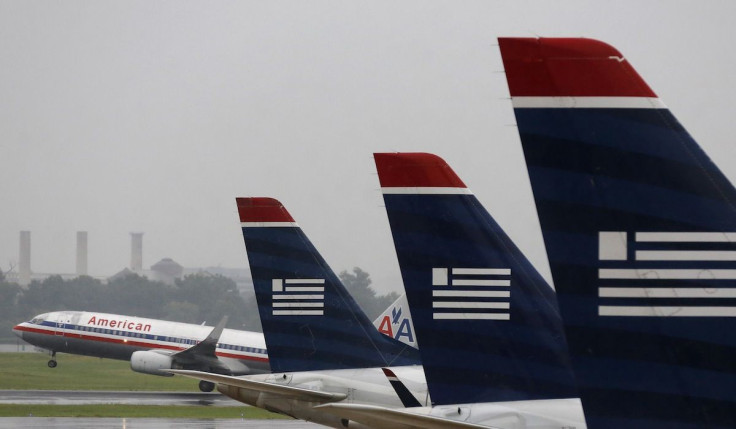American-US Airways Merger: 5 Things To Know About The Preliminary Deal

A proposed settlement with the U.S. Justice Department over an antitrust lawsuit Tuesday cleared the way for AMR Corporation (OTCQB:AAMRQ), parent company of American Airlines, and US Airways Group Inc. (NYSE:LLC) to proceed with their planned $17 billion merger. If approved by the court, the settlement would resolve the Justice Department’s concerns over competition and bless the creation of the world’s largest airline.
Here’s a look at five things you should know about the settlement and what will happen next.
More Airport Slots For Low-Cost Carriers
American Airlines and US Airways will both divest slots, gates and related facilities to emerging low-cost airlines to enhance systemwide competition in the industry. This was one of the major components of the proposed settlement, as the lawsuit argued that four legacy carriers with a history of “tacit coordination” would control more than 80 percent of the U.S. commercial air travel market.
The new plan will see low-cost carriers gain slots at key constrained airports across the country, such as Boston Logan, Chicago O’Hare, Los Angeles, Miami, New York LaGuardia and Ronald Reagan Washington National. Attorney General Eric Holder said this would provide the low-cost carriers with the incentive and ability to invest in new capacity, and allow them to compete more extensively in the domestic market.
“This agreement has the potential to shift the landscape of the airline industry. By guaranteeing a bigger foothold for low-cost carriers at key U.S. airports, this settlement ensures airline passengers will see more competition on nonstop and connecting routes throughout the country,” Holder said in a statement. “The department’s ultimate goal has remained steadfast throughout this process -- to ensure vigorous competition in airline travel. This is vital to millions of consumers who will benefit from both more competitive prices and enhanced travel options.”
Southwest Airlines And JetBlue Airways Stand To Gain
American and US Airways will have to give up a large number of slots and related facilities at two of the busiest airports on the East Coast: New York’s La Guardia (34 slots) and Washington’s Reagan National (104), opening up both airports to increased competition, according to the Justice Department.
Assistant Attorney General Bill Baer of the Department of Justice’s Antitrust Division stated Tuesday that the settlement “will disrupt the cozy relationships among the incumbent legacy carriers, increase access to key congested airports and provide consumers with more choices and more competitive airfares on flights all across the country.”
The divestitures, the largest ever in an airline merger, will occur through a DOJ-approved process following the merger’s completion. Analysts believe Southwest Airlines Co. (NYSE:LUV) and JetBlue Airways Corp. (NASDAQ:JBLU) could be the biggest winners of the Justice Department divestiture process as they both currently lease slots from American. Southwest shares rose by almost 1 percent Tuesday, while JetBlue shot up 4.9 percent.
The New American To Become World’s Largest Carrier
Tom Horton, chairman, president and CEO of AMR Corp., and incoming chairman of the board of the combined company, said the agreement with the Justice Department let it take the final steps in creating the new American Airlines. “With a renewed spirit, we are about to create the world's leading airline that will offer, along with our Oneworld partners, a comprehensive global network and service by the best people in the business. There is much more work ahead of us, but we're energized by the challenge and look forward to competing vigorously in the ever-changing global marketplace.”
AMR Corp. said that, despite the divestitures, it expected the new American to generate more than $1 billion in annual net synergies beginning in 2015. It added that the divestitures were not expected to affect total employment at the combined airline.
The new American will easily become the planet’s largest carrier, serving 336 destinations in 56 countries. It will offer more than 6,700 daily flights and likely become even more attractive to companies seeking direct routes to fly employees around the world, linking US Airways' smaller U.S. cities with American’s global network.
Merger Expected To Be Complete By December
The August antitrust lawsuit was a major curveball that nearly derailed the planned merger, which AMR Corp. and US Airways announced in February. Both companies had expected to complete the merger in the third quarter after winning the support of shareholders, creditors and European regulators. The carriers said Tuesday they now expect to complete the merger by December and give up slots and other rights at the seven key airports thereafter.
The new American, AMR said in an announcement Tuesday, is committed to maintaining hubs at New York JFK, Los Angeles, Miami, Chicago O’Hare, Philadelphia, Phoenix and Charlotte, N.C., for three years. It will also maintain American’s participation in the Oneworld alliance, which includes 13 global carriers and allows passengers to earn and redeem miles on partner airlines.
A Win For The Flying Public?
It’s too soon for passengers with existing tickets on American or US Airways to fret over the pending merger; absolutely nothing will change in the immediate future. Members of both frequent-flier programs should be fine, too, as the airlines will likely combine the miles into one program that would honor elite status and other features for both parties.
The bigger picture, however, may not be as rosy as we’ve been led to believe. Some analysts say that, despite the divestitures and despite the Justice Department’s talk of “more choices and more competitive airfares,” history points to a different story.
The airline industry has seen a rash of mergers in recent years, including United-Continental, Delta-Northwest and Southwest-AirTran. All the while, the price of a domestic roundtrip flight has climbed by more than 15 percent (adjusted for inflation) since 2009, according to figures from the Bureau of Transportation Statistics.
The merger is expected to give the new American the ability to raise fares, and its biggest competitors are likely to follow suit. Whether or not an increased presence by low-cost carriers like JetBlue, Southwest, Spirit and Allegiant can drive prices down remains to be seen.
© Copyright IBTimes 2024. All rights reserved.






















